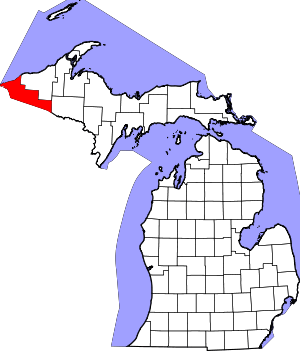Bessemer Township, Michigan
| Bessemer Township, Michigan | |
|---|---|
| Township | |
 Bessemer Township, Michigan Location within the state of Michigan | |
| Coordinates: 46°25′14″N 89°59′51″W / 46.42056°N 89.99750°WCoordinates: 46°25′14″N 89°59′51″W / 46.42056°N 89.99750°W | |
| Country | United States |
| State | Michigan |
| County | Gogebic |
| Area | |
| • Total | 115.4 sq mi (298.9 km2) |
| • Land | 113.8 sq mi (294.9 km2) |
| • Water | 1.6 sq mi (4.0 km2) |
| Elevation | 1,549 ft (472 m) |
| Population (2010) | |
| • Total | 1,176 |
| • Density | 11.2/sq mi (4.3/km2) |
| Time zone | Central (CST) (UTC-6) |
| • Summer (DST) | CDT (UTC-5) |
| ZIP code | 49911 |
| Area code(s) | 906 |
| FIPS code | 26-07980[1] |
| GNIS feature ID | 1625929[2] |
Bessemer Township is a civil township of Gogebic County in the U.S. state of Michigan. As of the 2010 census, the township population was 1,176.
Communities
- Anvil Location was a village in the township with an iron mine operated by Newport Mining Company. It was established in 1886 and got a post office in 1918.[3]
- The City of Bessemer is situated within the township, but is administratively autonomous.
- Dunham was an unincorporated community centered around a station on the Chicago and Northwestern Railroad. There was a plant of the Ashland Iron and Steel Company here. It had a post office from 1902 until 1911.[4]
- Ramsay is an unincorporated community within the township at 46°28′13″N 89°59′48″W / 46.47028°N 89.99667°W. It is on the Black River just south of U.S. Highway 2 a few miles west of Wakefield and a few miles east of Bessemer.[5]
Geography
According to the United States Census Bureau, the township has a total area of 115.4 square miles (299 km2), of which 113.8 square miles (295 km2) is land and 1.6 square miles (4.1 km2) (1.35%) is water.
Demographics
As of the census[1] of 2010, there were 1,176 people. As of the 2000 Census, there were 578 households, and 362 families residing in the township. The population density was 11.2 per square mile (4.3/km²). There were 946 housing units at an average density of 8.3 per square mile (3.2/km²). The racial makeup of the township was 97.24% White, 0.39% African American, 0.71% Native American, 0.31% Asian, and 1.34% from two or more races. Hispanic or Latino of any race were 0.16% of the population. 23.5% were of Finnish, 15.2% Italian, 13.4% German, 8.7% Swedish, 7.8% Polish and 7.0% English ancestry according to Census 2000.
There were 578 households out of which 22.8% had children under the age of 18 living with them, 51.4% were married couples living together, 8.0% had a female householder with no husband present, and 37.2% were non-families. 34.3% of all households were made up of individuals and 19.7% had someone living alone who was 65 years of age or older. The average household size was 2.20 and the average family size was 2.79.
In the township the population was spread out with 19.3% under the age of 18, 7.5% from 18 to 24, 24.3% from 25 to 44, 28.4% from 45 to 64, and 20.6% who were 65 years of age or older. The median age was 44 years. For every 100 females there were 107.2 males. For every 100 females age 18 and over, there were 100.6 males.
The median income for a household in the township was $27,000, and the median income for a family was $32,941. Males had a median income of $27,381 versus $21,607 for females. The per capita income for the township was $18,917. About 7.7% of families and 8.9% of the population were below the poverty line, including 12.0% of those under age 18 and 11.0% of those age 65 or over.
References
Notes
Sources
- Romig, Walter (October 1, 1986) [1973]. Michigan Place Names: The History of the Founding and the Naming of More Than Five Thousand Past and Present Michigan Communities. Great Lakes Books Series (Paperback) (Detroit, Michigan: Wayne State University Press). ISBN 081431838X. ISBN 978-0814318386.
| |||||||||||||||||||||||||||||||||
